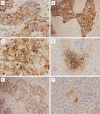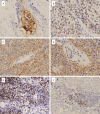Immunohistochemical differentiation between type B3 thymomas and thymic squamous cell carcinomas
- PMID: 26191237
- PMCID: PMC4503108
Immunohistochemical differentiation between type B3 thymomas and thymic squamous cell carcinomas
Abstract
Type B3 thymomas and thymic squamous cell carcinomas have some overlapping histological features, so it is difficult to make the differential diagnosis between these two entities, especially when the biopsy specimen is small. Only a few markers such as CD5 and CD 117 were applied to the differential diagnosis, the purpose of this study is to identify other diagnostic markers to help making the differential diagnosis more accurate. GLUT-1, MUC-1, CD117, CD5, CEA, P63, CK19, CK5/6, CD1a and TdT were evaluated using 16 cases of type B3 thymoma and 20 cases of thymic squamous cell carcinoma. Staining scores were obtained by calculating the percentage of positive cells. The sensitivity of GLUT-1 or MUC-1 for thymic squamous cell carcinomas was highest (100%), followed by CK5/6 (95%), CD117 (90%), P63 (85%), CD5 (80%) and CEA (75%). The specificities of CD5, CD117 and CEA for thymic squamous cell carcinomas all were 100%, next was MUC-1 (56.3%), followed by GLUT-1 (50%), P63 (25%), CK5/6 (12.5%). The sensitivities of CK19, TdT, and CD1a for type B3 thymomas were 100%, 93.8% and 87.5%, respectively. The specificity of CD1a for type B3 thymomas was highest (100%), followed by TdT (95%), CK19 (10%). The reactivity of GLUT-1, MUC-1, CD117, CD5, CEA, CD1a and TdT in thymic squamous cell carcinomas and type B3 thymomas had significant difference. Usually a panel of markers is needed, if we combine GLUT-1 or MUC-1 which sensitivity for thymic squamous cell carcinomas is highest with CD5, CD117, CEA, CD1a or TdT which have high specificity, we can make the differential diagnosis effectively.
Keywords: Type B3 thymoma; differentiation; immunohistochemistry; thymic squamous cell carcinoma.
Figures



References
-
- Müller-Hermelink HK, Engel P, Kuo TT, et al. Pathology & Genetics, Tumours of the Lung, Pleura, Thymus and Heart. Lyon: IARC Press; 2004. Tumors of the Thymus; pp. 145–247.
-
- Kojika M, Ishii1 G, Yoshida J, Nishimura M, Hishida T, Ota SJ, Murata Y, Nagai K, Ochiai A. Immunohistochemical differential diagnosis between thymic carcinoma and type B3 thymoma: diagnostic utility of hypoxic marker, GLUT-1, in thymic epithelial neoplasms. Mod Pathol. 2009;22:1341–50. - PubMed
-
- Berezowski K, Grimes MM, Gal A, Kornstein MJ. CD5 immunoreactivity of epithelial cells in thymic carcinoma and CASTLE using paraffin-embedded tissue. Am J Clin Pathol. 1996;106:483–6. - PubMed
-
- Pan CC, Chen PC, Chiang H. KIT (CD117) is frequently overexpressed in thymic carcinomas but is absent in thymomas. J Pathol. 2004;202:375–81. - PubMed
Publication types
MeSH terms
Substances
LinkOut - more resources
Full Text Sources
Medical
Research Materials
Miscellaneous
